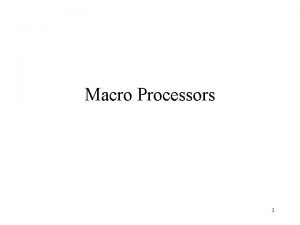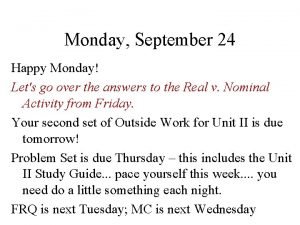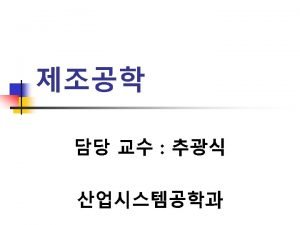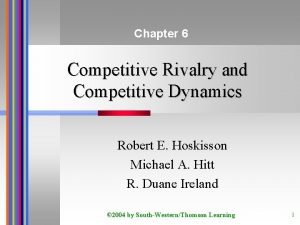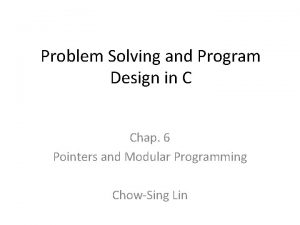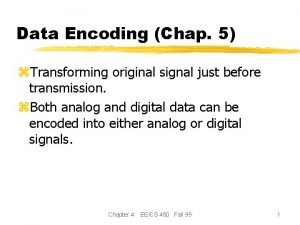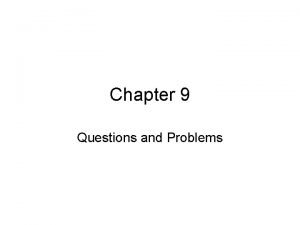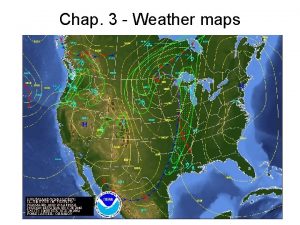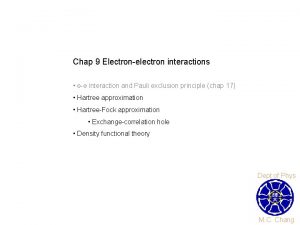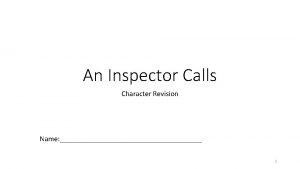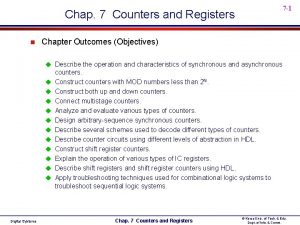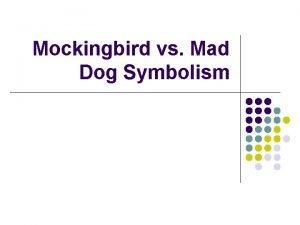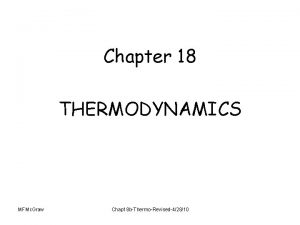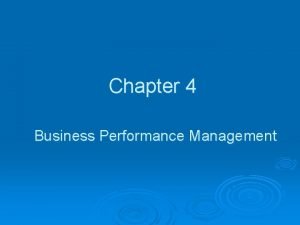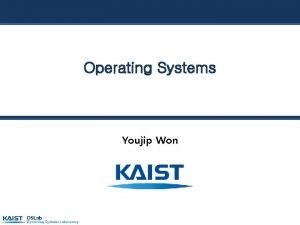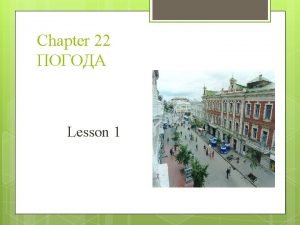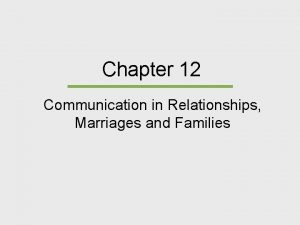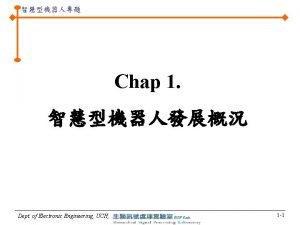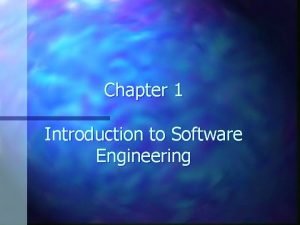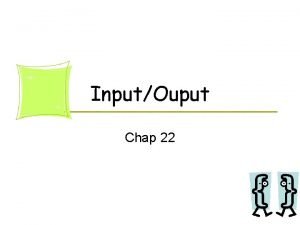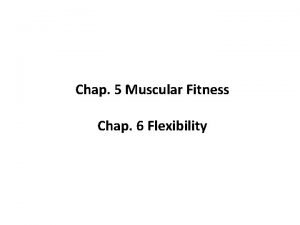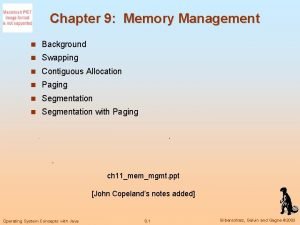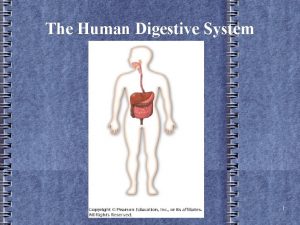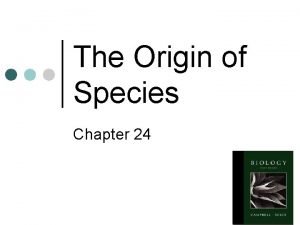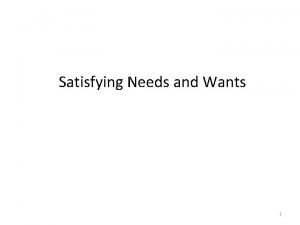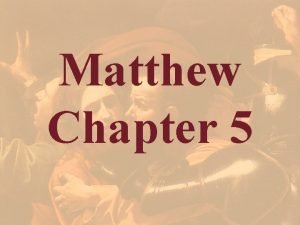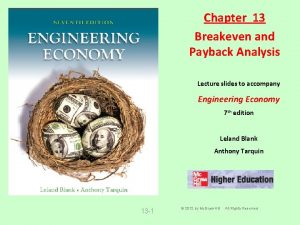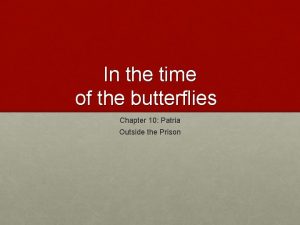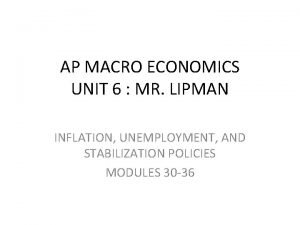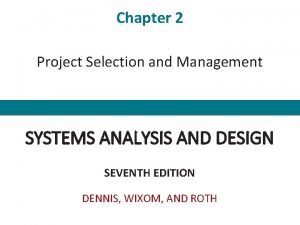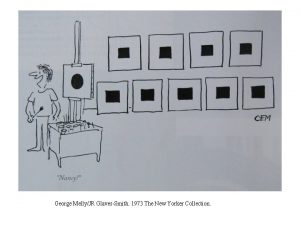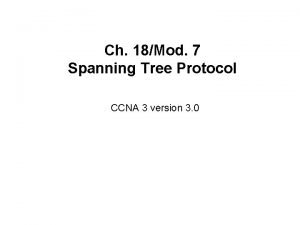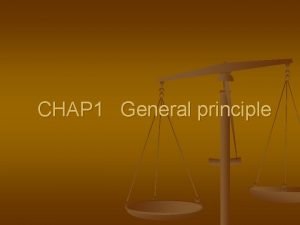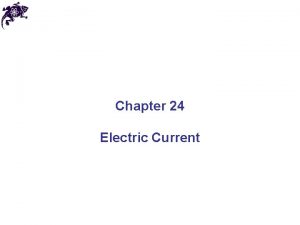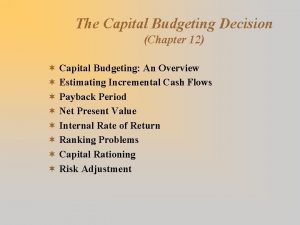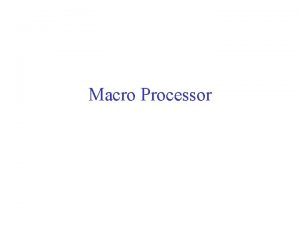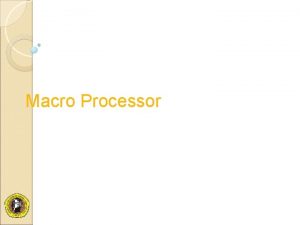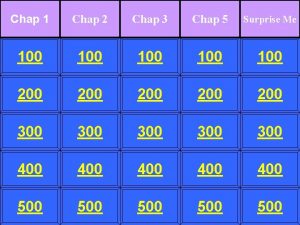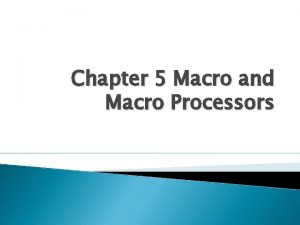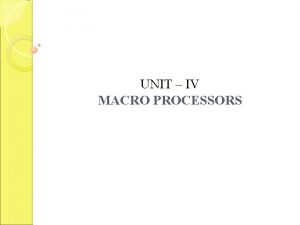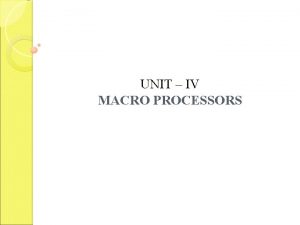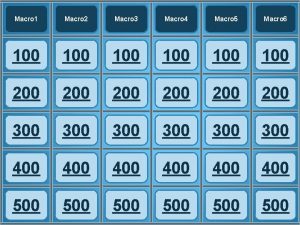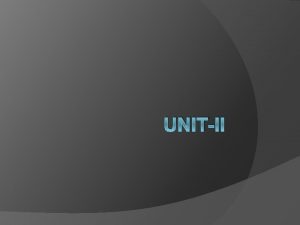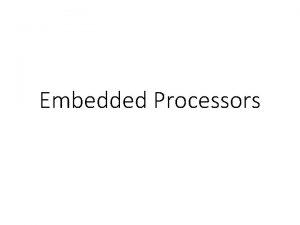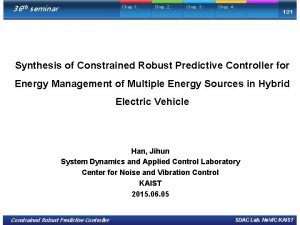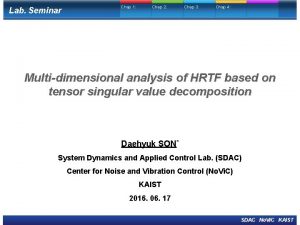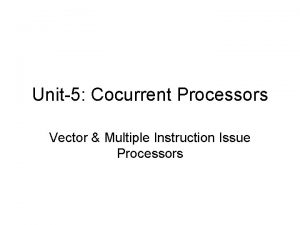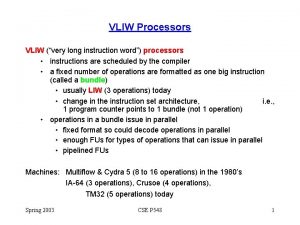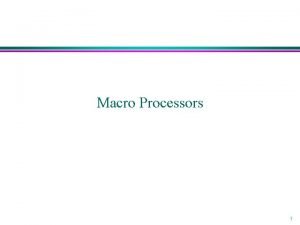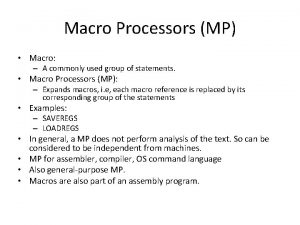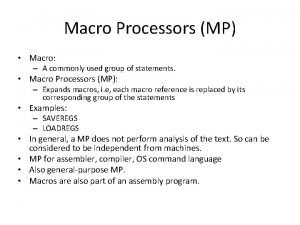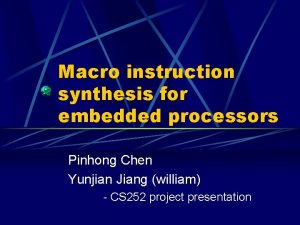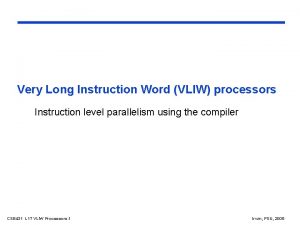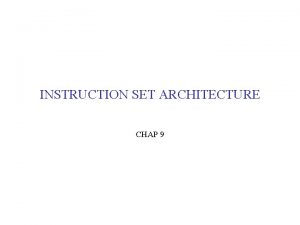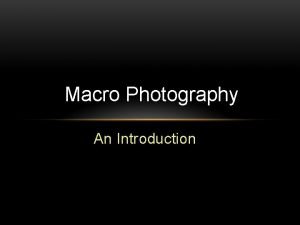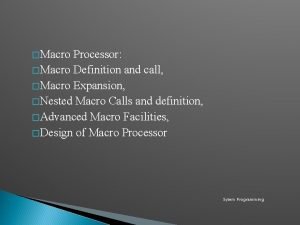CHAP 4 MACRO PROCESSORS Macro Processors Macro instruction





















































- Slides: 53

CHAP 4 MACRO PROCESSORS

Macro Processors Macro instruction represents a commonly used group of statements in the source programming language. Expanding the macros by the macro processor.

Definition and Expansion Program has the same functions and logic as the sample program, the numbering scheme used for the source statements. Program defines and uses two macro instructions, RDBUFF, the WRBUFF macro is similar to the WRREC.

Definition and Expansion MACRO and MEND are used in macro, (line 10) identifies the beginning of a macro definition. The operand field identify the parameters of the macro invocation statement that gives the arguments to be used in expanding. Input to a macro processor, output that would be generated, expended into the macro invocation corresponds to the first parameter.

Macro invocation and Subroutine call The most significant difference between macro invocation and subroutine call : statements that from the expansion of a macro are generated each time the macro is invoked but statements in a subroutine call appear only once, regardless of how many times the subroutine is called.

Macro invocation and Subroutine call The macro invocation statement itself has been included as a comment documentation of statement written by the programmer. Macro instruction in exactly the same way as an assembler language mnemonic. The expanded file used as input to the assembler. A duplicate label definition, eliminated from the body of our macro definitions.

Subroutine call V. S. Macro call WRBUFF RDBUFF Main RDREC 呼叫 兩次 WRREC Fig 2. 5 Subroutine call 節省 程式空間, 因 need stack structure 所以 執行速度慢 Macro call 耗費 程式空間, 執行速度 快 190 a 190 m 210 a 210 h 220 a 220 h Main EXPAND … RDBUFF WRBUFF Main

Macro and no Macro Compare the example program in figure 4. 1 with 2. 5. Fig 4. 1 Fig 4. 5 define expand Fig 4. 4 Fig 4. 2

Macro Process Source code macro process define Macro processor expand Marco data structure Assembler Object code

Data structures in Macro processor There are three main data structures involved in macro processor : DEFTAB : define table, the macro body, NAMTAB : name table, index to DEFTAB, ARGTAB : arguments.

Data structures in Macro processor Two-pass macro processor in which all macro definitions during the first pass, and invocation statements are expanded during the second pass, macro instruction definitions in Fig. 4. 3.

Data structures in Macro processor Processor that can alternate between macro definition is able to handle macros like those in Fig. 4. 3. Macro invocation statement that preceded the definition of the confusing anyone reading the program. Definition table (DEFTAB), comment lines the macro definition are not DEFTAB. The macro entered into NAMTAB, an index to DEFTAB. For the beginning and end in DEFTAB.

Figure 4. 3 Example of the definition of macros within a macro body

Data structures in Macro processor Argument table (ARGTAB), the arguments are stored in ARGTAB according to their position in the argument list. ARGTAB are substituted for the corresponding parameters in the macro body. Figure. 4. 4(a) shows the definition, entry in NAMTAB identifying the beginning and end of the definition.

DEFTAB. . NAMTAB. . RDBUFF. . . RDBUFF &INDEV, &BUFADR, &RECLTH CLEAR X CLEAR A CLEAR S +LDT #4096 TD =X’? 1’ JEQ *-3 RD =X’? 1’ CLEAR A, S JEQ *+11 STCH ? 2, X TIXR T JLT *-19 STX ? 3 MEND . . Figure 4. 4

Data structures in Macro processor The parameter &INDEV has been converted to ? 1 (indicating the first parameter in the prototype), &BUFADR has been converted to ? 2, and so on. Notation is recognized in a line from DEFTAB. The procedure DEFINE, which is called when the beginning of a macro definition is recognized, DEFTAB and NAMTAB. EXPAND is called to set up the argument values in ARGTAB.

Data structures in Macro processor The normal approach would be to directive is reached. DEFINE procedure maintains named LEVEL. Each time a MACRO directive is read, the value of LEVEL is increased by 1; MEND directive is read, the value of LEVEL is decreased by 1. Figure 4. 5 Algorithm for a one-pass macro processor

Fig 4. 5 Algorithm for a one-pass macro processor GETLINE macro Read next … GETLINE PROCESSLINE Found PROCESSLINE macro NAMTAB Write source to expand (fig 4. 2) DEFTAB DEFINE RDBUFF ARGTAB WRBUFF 1. enter macro name in NAMTAB 2. enter macro prototype into DEFTAB 3, 4. while~ end{while} 用來處理 macro中再定 義macro使用 (如Fig 4. 3) EXPAND

Data structures in Macro processor Mention before, these extended features are not directly related to the architecture of the computer for Concatenation of Macro Parameters.

Data structures in Macro processor

Data structures in Macro processor Concatenation of macro parameters : concatenates macro instruction parameters with other character. define SUM MACRO &ID LDA X&ID 1 use SUM A SUM BETA LDA XA 1 LDA XBETA 1

4. 2. 2 Generation of Unique Labels Definition would prevent correct assembly of the resulting expanded program. Technique for generating unique labels within expansion. Labels used within the macro body begin with the special character $. Replacing $ with $AA, the character $ will be replaced by $xx.

4. 2. 2 Generation of Unique Labels Method for generating unique labels within macro expansions lets the labels beginning with the special character $. During expansion each symbol beginning with $ has been modified by replacing $ with $AA. ex. 1 st $AA, 2 nd $AB, 3 rd $AC

4. 2. 3 Conditional macro expansion 1/13 These statement could be varied by the substitution of parameters, the sequence of statements generated for a macro expansion, the arguments supplied in the macro invocation. For this reason, we prefer to use the term conditional macro expansion. Definition of RDBUFF has two additional parameters: &EOR, which specifies.

2/13 Figure 4. 8 Use of macro- time conditional statements.

4. 2. 3 Conditional macro expansion The statements on lines 44 though 48 of this definition illustrate conditional structure. &MAXLTH is equal to the null string, the statement on line 45 is generated. Otherwise, the statement on line 47 is generated. 3/13

4. 2. 3 Conditional macro expansion (1) A simple macro-time conditional structure: IF-ELSE-ENDIF 4/13

4. 2. 3 Conditional macro expansion 5/13 The conditional macro expansion features just described is relatively simple. Processor must maintain a symbol table that contains the values of all macro-time variables used. IF statement is encountered during the expansion of a macro, processor continues to process lines from DEFTAB until it encounters the next ELSE or ENDIF statement.

4. 2. 3 Conditional macro expansion 6/13 Fig. 4. 9 show anther definition of RDBUFF. The macro-time variable &EORCT has previously been set (line 27) to the value %NITEMS(&EOR). 27 63 64 70 &EORCT &CTR SET WHILE JEQ %NITEMS(&EOR) 1 (&CTR LE &EORCT) $EXIT

4. 2. 3 Conditional macro expansion 7/13 The implementation of a macro-time looping statement such as WHILE is also relatively simple. The specified Boolean expression is evaluated. FALES, the macro processor skips ahead in DEFTAB until it.

4. 2. 3 Conditional macro expansion (2) A macro-time variable : &EORCK 8/13

4. 2. 3 Conditional macro expansion 9/13 (3) The implementation of the conditional macro expansion: (Boolean expression)

4. 2. 3 Conditional macro expansion (4) A macro-time looping statement: WHILE-ENDW 10/13

4. 2. 3 Conditional macro expansion 11/13 (5) A macro processor faction %NITEMS: if &EOR=(00, 03, 04), then %TNITEMS(&EOR)=3

4. 2. 3 Conditional macro expansion (6) A macro-time counter variable &CTR 12/13

4. 2. 3 Conditional macro expansion (7) How do you implement nested IF or nested WHILE macro-time conditional statement? Sol: modify the algorithm in Fig 4. 5 13/13

4. 2. 4 Keyword macro parameters Keyword macro parameters have seen thus far used positional parameters. Parameters and arguments were associated with each other according to their positions in the macro prototype and the macro invocation. Macro has a large number of parameters, and only a few of these are given values in a typical invocation.

4. 2. 4 Keyword macro parameters particular invocation of the macro, positional parameters were used, the macro invocation statement might look like keyword parameters, parameter in any order. GENER TYPE=DIRECT, CHANNEL=3 A version of the RDBUFF macro definition using keyword parameters.

4. 2. 4 Keyword macro parameters Using keyword parameters, each argument values is written with a keyword that names the corresponding parameter. ex. define RDBUFF MACRO &INDEV=F 1, &BUFADR=, &RECLTH=, &EOR=04, &MAXLTH=4096 use RDBUFF MACRO BUFADR=BUFFER, RECLTH=LENGTH Fig 4. 10

4. 2. 4 Keyword macro parameters Using keyword parameters, each argument values is written with a keyword that names the corresponding parameter. ex. define RDBUFF MACRO &INDEV=F 1, &BUFADR=, &RECLTH=, &EOR=04, &MAXLTH=4096 use RDBUFF MACRO BUFADR=BUFFER, RECLTH=LENGTH Fig 4. 10

4. 3 Macro parameters design options The algorithm presented in Fig. 4. 5 does not work properly if a macro RDBUFF BUFADR=BUFFER, RECLTH=LENGTH RDBUFF RECLTH=LENTH, BUFADR=BUFFER, EOR=, INDEV=F 3 desirable to allow macros to be used in this way, possibilities for the solution of these problems.

4. 3. 1 Recursive macro expansion The definition of one macro instruction. However, dealt with the invocation of one macro. Example of such a use of macros assumed that a related macro instruction already exists. This macro appears in Fig. 4. 11(b). Macro like RDCHAR in the definition of RDBUFF so that 50 $LOOP RDCHAR &INDEV The algorithm were applied to the macro invocation statement in Fig. 4. 11(c).

4. 3. 1 Recursive macro expansion ARGTAB as follows: Parameter Value 1 BUFFER 2 LENGTH 3 F 1 4 (unused) ˙ ˙ The Boolean variable EXPANDING, would be set until line 50, a statement invoking RDCHAR. PROCESSLINE would call EXPAND again.

4. 3. 1 Recursive macro expansion RDCHAR was recognized, EXPANDING would be set to FALSE. The macro processor would “forget” that it had been in the middle of expanding a macro when it encountered the RDCHAR statement. These difficulties is the recursive call of the procedure is encountered, EXPAND is called. PROCESSLINE for line 50, which results in another call to EXPAND before a return is made from the original call. PROCESSLINE should be made to the main (outermost) loop of the loop within EXPAND.

4. 3. 1 Recursive macro expansion Processor is being a programming language that allows recursive calls. The compiler would be sure that previous values of any variables within a procedure were saved when procedures at all, implementation can be found.

4. 3. 1 Recursive macro expansion The algorithm of a macro processor described in figure 4. 5 cannot handle the invocations of macros within macros. the problem can be solved by using stack structure. RDBUFFER, LENGTH, F 1 Parameter Va. P luaerameter RDCHAR F 1 Val. P uaerameter 1 BUFFER 1 2 LENGTH 2 BUFFER 2 3 F 1 LENGTH 3 4 3 F 1 . (unused 4) 5 (unused) cover. F 1 1 4 Value F 1 (unused)

4. 3. 2 General-purpose macro processors Why are there few general-purpose macro processors? --easy for beginner, detail free. (1) (2) parameter substitution, ex. comments ; grouping structure, ex. begin-end ; (3) tokens, ex. : = ; (4) syntax for macro definition and invocation.

4. 3. 2 General-purpose macro processors These are not dependent on any particular programming language, with a variety of different languages. Keywords such as begin and end for groping statements. The programming language for example, identifiers, constants, operators, and keywords statements.

4. 3. 3 Macro processing within language translators (1) Pre-processors (2) Line-by-line macro processor : * macro efficient. * easy to give diagnostic messages. * loosed-coupled relation. 1/5

4. 3. 3 Macro processing within language translators 2/5 Macro definitions and expanded version of the source program. The macro processing functions with the language translator itself. The macro processor operates as a sort of input routine for the assembler or compiler.

4. 3. 3 Macro processing within language translators 3/5 Extra pass over the source program, OPTAB in an assembler and NAMTAB implemented in the same table. A line-by-line macro processor also makes it easier to give diagnostic mess ages that are related to the source statement containing to backtrack to discover the original source of trouble.

4. 3. 3 Macro processing within language translators 4/5 (3) Integrated macro processor : A FORTRAN compiler must be able to recognize and handle situations such as follows: Do 100 I=1, 20 對於I相對20. . Do 100 I=1 變數Do 100 I設為 1 disadvantages : * more expensive * larger and more complex

4. 3. 3 Macro processing within language translators 5/5 Assignment statement that gives the variable DO 100 I, the variable name I and handle situations such as this. Integrated macro processor can support macro instructions that depend upon the processor development must cost of the language translator with limited memory.
 Chap chap slide
Chap chap slide Macro instruction
Macro instruction Macro instruction
Macro instruction Differentiated instruction vs individualized instruction
Differentiated instruction vs individualized instruction Direct instruction method
Direct instruction method Econmovies episode 6 worksheet answers
Econmovies episode 6 worksheet answers Any movement that works the larger muscles of the body
Any movement that works the larger muscles of the body Hình cắt kết hợp
Hình cắt kết hợp Chap tools
Chap tools Rivalry ch 6
Rivalry ch 6 C chap
C chap Chap a to z
Chap a to z Building responsible relationships
Building responsible relationships Autocorrelation ppt gujarati
Autocorrelation ppt gujarati Payback chap 9
Payback chap 9 Surface weather station model
Surface weather station model Lindhard theory
Lindhard theory I was in that state when a chap easily turns nasty analysis
I was in that state when a chap easily turns nasty analysis Chap counter
Chap counter The origin of species chapter 19 manhwa
The origin of species chapter 19 manhwa Find the passage
Find the passage To not die chap 18
To not die chap 18 1 of 1 clothing meaning
1 of 1 clothing meaning Business performance chap 1
Business performance chap 1 Youjip won
Youjip won In the summer chap 22
In the summer chap 22 Define the relationship chap 12
Define the relationship chap 12 Chap. 1
Chap. 1 Fitness chapter 3
Fitness chapter 3 System engineer chap 1
System engineer chap 1 Chap 22
Chap 22 Fitness chap 70
Fitness chap 70 Spicy riddles worksheet with answers
Spicy riddles worksheet with answers Swapping ch 9
Swapping ch 9 Chap 23
Chap 23 What does chap look like
What does chap look like The origin of species chapter 24 bl
The origin of species chapter 24 bl Kip chap
Kip chap Needs and wants that has been satisfied
Needs and wants that has been satisfied Matthews chapter 5
Matthews chapter 5 Payback analysis
Payback analysis Passion chap 6
Passion chap 6 The butterfly inside chapter 10
The butterfly inside chapter 10 Chap lipman
Chap lipman Project selection in system analysis and design
Project selection in system analysis and design Fitness chap 1
Fitness chap 1 Khan academy nernst equation
Khan academy nernst equation Chap tree
Chap tree Rottgen pieta
Rottgen pieta Kstn chap 18
Kstn chap 18 Pleasure principle chap 1
Pleasure principle chap 1 Define the relationship chap 7
Define the relationship chap 7 Chapter 24
Chapter 24 Payback chapter 12
Payback chapter 12

